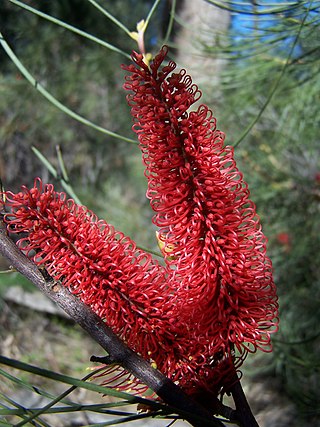
Hakea bucculenta, commonly known as red pokers, is a large shrub in the family Proteaceae endemic to Western Australia. It is an ornamental shrub with red or orange flowers that appear in rod-like blooms in leaf axils for an extended period from May to November.

Hakea scoparia is a species of flowering plant in the family Proteaceae and is endemic to the south-west of Western Australia where it grows in shrubland. It is a shrub with ascending branches, terete leaves and clusters of cream to pinkish flowers in leaf axils from June to September.
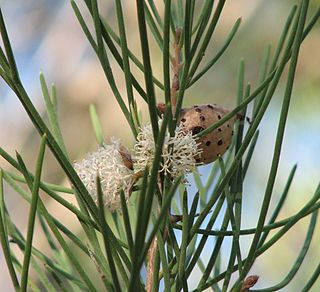
Hakea drupacea, commonly known as sweet-scented hakea, is a tree or shrub which is native to south west Western Australia.

Hakea cygna, commonly known as the swan hakea, is a species of flowering plant in the family Proteaceae. It usually grows as a dense shrub with creamy-white upright flowers appearing from July to August. It is endemic to Western Australia.
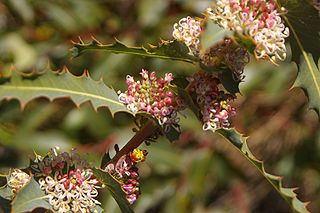
Hakea amplexicaulis, commonly known as prickly hakea, is a shrub endemic to south west Western Australia. An attractive small shrub with unusual stem clasping, sharply serrated foliage and a profusion of sweetly scented variable coloured flowers from late winter to spring.
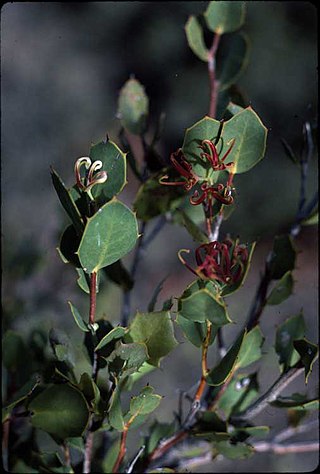
Hakea denticulata, commonly known as stinking Roger, is a species of shrub or tree endemic southern Western Australia. It is one of the many species of Australian plant described by the botanist Robert Brown. It is a compact shrub 1–2 m (3–7 ft) high and wide with red flowers in the spring with an unpleasant odour.

Hakea cristata, commonly known as the snail hakea, is a shrub in the family Proteaceae native to Western Australia. An ornamental prickly shrub with attractive foliage and creamy white rounded flowers appearing in profusion in the winter months.
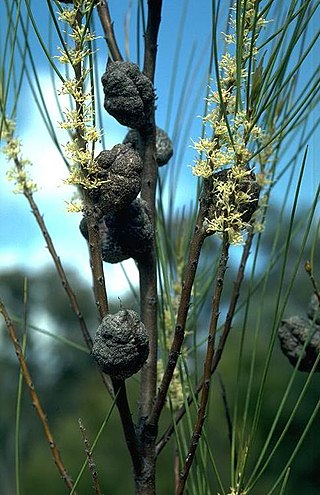
Hakea dohertyi, commonly known as the Kowmung hakea, is a shrub endemic to a restricted locale in the Great Dividing Range in central New South Wales in Australia.

Hakea cucullata, commonly known as hood-leaved hakea, cup hakea or scallop hakea, is a species of shrub in the family Proteaceae and is endemic to the south-west of Western Australia. It is an attractive shrub with distinctive foliage and beautiful large pink, red, or deep purple scented flowers.

Hakea ambigua is a shrub in the family Proteaceae. In favourable conditions may grow into an attractive weeping shrub with creamy white flowers. Only found in the Stirling Ranges of southern Western Australia.
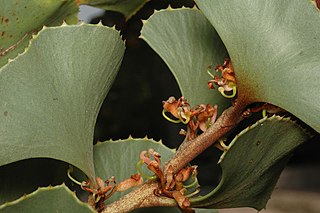
Hakea brownii commonly known fan-leaf hakea is a shrub in the family Proteaceae native to an area in the Wheatbelt region of Western Australia. This species shares a common name with Hakea baxteri due to its distinctive leaves.

Hakea candolleana is a shrub in the family Proteaceae native to areas along the west coast in the Wheatbelt and Mid West regions of Western Australia. A cream-white winter flowering species, useful as a garden ground cover.

a

Hakea conchifolia, commonly known as the shell-leaved hakea, is a shrub in the family Proteaceae native to an area in the west coast of the Wheatbelt region of Western Australia. An attractive small species with unusual rigid leaves that encircle the flowers.

Hakea carinata is a species in the family Proteaceae native to an area in South Australia. It is a frost hardy small to medium shrub adaptable to a range of free draining situations. Its prickly habit creates a good wildlife habitat.

Hakea erecta is a shrub in the family Proteaceae and is endemic to Western Australia. It is a dense rounded shrub with linear twisted leaves and up to 24 pink or white fragrant flowers appearing in leaf axils in spring.

Hakea tuberculata is a flowering plant in the family Proteaceae and is endemic to several isolated areas along the coast in the Peel, South West, Great Southern and Goldfields-Esperance regions of Western Australia. It is an upright shrub with white flowers and rigid, prickly leaves.

Hakea meisneriana is a shrub in the family Proteaceae and is endemic to Western Australia. It has small, nectar rich, creamy white flowers in clusters in the upper branches from August to November.
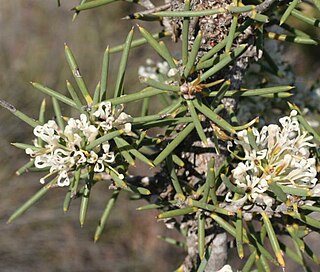
Hakea psilorrhyncha is a flowering plant in the family Proteaceae, it is endemic to a small area on the west coast in the Wheatbelt and Mid West regions of Western Australia. It has needle-shaped, sharply pointed leaves and clusters of scented brownish yellow flowers.

Hakea stenophylla is a shrub or tree in the family Proteaceae, with sweetly scented creamy-white flowers. It is endemic to Western Australia.





















